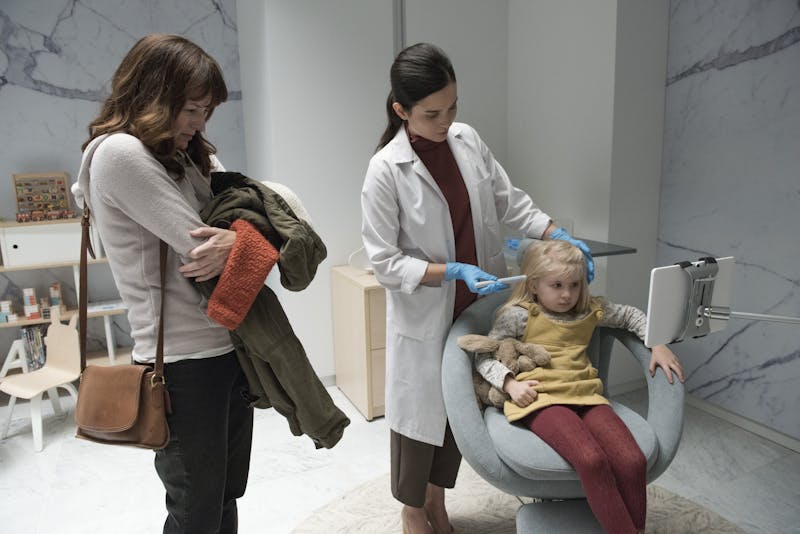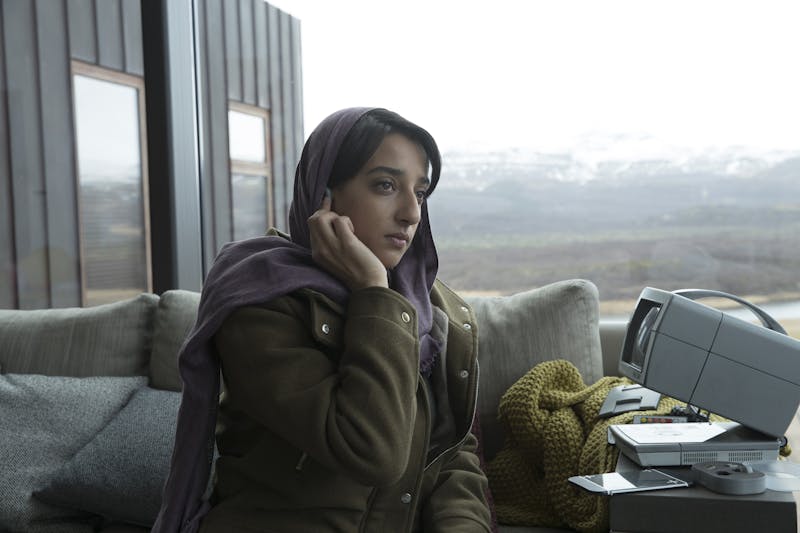Jean Paul Sartre’s play No Exit, famous for the line “Hell is other people,” is titled Huis Clos in French. That phrase is the equivalent of the English legal term “in camera,” which is Latin for “in the chamber”—in a closed room, away from the media. In No Exit, three sinners are locked in a room together. Each is surprised that eternal damnation is like this. They had expected flames.
In a 1946 review, Stark Young wrote in The New Republic that No Exit “should be seen whether you like it or not.” If that description of a locked-room confession plot reminds you of a certain episode of a certain contemporary television show, you are on the money. Press harder on the words “in camera” and you’ll get there for sure: What might it mean to be a camera, to be locked inside a machine that sees?
In December Black Mirror plunked season four down on Netflix. (This review contains many spoilers.) The show started its life on U.K.’s Channel 4, but after Netflix acquired it in 2016 it pitched toward international interests by casting Americans and reducing the allusions to British politics. This season has also reduced and clarified the themes under the show’s microscope, and therefore focused Black Mirror into a more coherent work. Those themes, incidentally, are the same as Jean Paul Sartre’s. What is hell, and are we in it?

Unlike the previous seasons, no episode in season four explicitly refers to governmental politics, state surveillance, or law enforcement and the military. Instead, almost every episode runs with the major theme introduced in “White Christmas,” the special extra episode that followed season two.
In “White Christmas,” a man named Matt (played by John Hamm) sells a device to a fussy, wealthy woman that replicates her consciousness. He then traps that second consciousness in a device where her only task is to control the original-self’s household: toasting the toast, opening the curtains, and so on. The second-self is appalled and traumatized by her detention, since she still feels herself to be normal. But Matt, as the device controller, gives her six months in solitary with nothing to do until she is “broken.” The second-self submits to her task and toasts the toast.
The key concept here is of human consciousness placed inside a small device, where it has its subjective existence but no agency in the real world. That is Black Mirror’s innovation in the craft of hell-making. In season four, this concept animates the episodes “USS Callister,” “Black Museum,” and “Hang the DJ.” Two episodes, “Arkangel” and “Crocodile,” are both about devices that compromise human autonomy through surveillance. “Metalhead” is a fairly simple race against killer machines, and I’m not sure it’s about anything except Amazon drones coming to kill us all.
“USS Callister” has perhaps the strongest concept of all the new episodes. The chief technology officer of a startup feels maligned and marginalized by his employees, some of whom are female and don’t respect him. He customizes a version of his virtual reality product. By sequencing the covertly acquired DNA of his colleagues, he can turn them into characters in the game, where he can live out his adolescent fantasies of commanding a Star Trek-like vessel, complete with superpowers. But those replicated individuals have consciousness, and feel themselves to be trapped by an “asshole God.” The CTO can turn them into monsters. He can kill them over and over again. He can make their skin cover their faces so that they cannot breathe but also do not die. They ultimately become aware of their condition, and manage to escape.
In “Hang the DJ,” the consciousness of those trapped is only partial. Two people meet on a date within a system that dictates an arbitrary time limit to all relationships. They’re unsatisfied with all others but forbidden to remain together. It turns out by the episode’s end, however, that the real challenge was to realize that they must rebel against the system: that is the test of true love. Upon escape the couple beam into a room containing 999 other versions of themselves. Their love was simply a playtest inside a dating app, figuring out what percentage of simulated relationships between two randos in a bar will result in a rebellion, meaning compatibility.
If feeling real is not the same as being real, then what is the difference between being and feeling? Again and again, Black Mirror concludes that the difference lies in agency. In “Black Museum,” a curator named Rolo Haynes presents several “exhibits” from the Black Mirror universe, telling their stories to a young visitor. The curator was in his former career a “med-tech” innovator. One of his clients was Jack, whose wife Carrie was in a persistent vegetative state. In order to let her hug her son once again, Haynes offers to implant her consciousness into her husband’s. She can experience his senses and watch the world from the driver’s seat of his mind, without being able to drive.
Eventually, the couple bicker. Jack starts to “pause” Carrie. After Jack begins a new relationship, Haynes offers to resolve the problems in their triangle by downgrading Carrie’s “vehicle” to a stuffed monkey. Jack gives the monkey to their son, who can hug her. Carrie can now only express her feelings via a binary set of expressions: “Monkey loves you!” or “Monkey needs a hug!” The child tires of the monkey. The monkey now sits in Haynes’s museum, still staring out of its glassy eyes.
In this hell, Carrie knows herself to be real but her scope of existence in the world has been so reduced. In the final horrible exhibit of Haynes’s museum, we see a person whose agency has been removed but who, further, has been made to suffer. Haynes has bought the post-mortem digital version of Clayton Leigh, a man convicted of murder on shaky evidence. Leigh can feel. Haynes allows his visitors, many motivated by racist sadism, to execute Leigh over and over again. (Leigh’s predicament echoes that of the death row inmate Clayton Lockett, whose execution in Oklahoma in 2014 was horrendously botched.) As with the imprisoned woman of “White Christmas,” the key, Haynes says, is to only torture him for a few seconds at a time—after that he would break completely, and become useless. Each visitor can take home a miniaturized Leigh consciousness on a keychain, screaming in agony forever.
The torture-keychain represents the apotheosis of Black Mirror’s hell principle. Not only can consciousness be duplicated and trapped in objects, stripped of verbal and physical agency, but now those objects are trinkets. Leigh’s agony does not have a function in the meaningful market of things. Instead, his consciousness has undergone object-fetishization. It is an extra, a remnant, a physical shorthand for memory: a souvenir.

“I’m going to smile, and my smile will sink down into your pupils, and heaven knows what it will become.” There are no mirrors in the sealed room of No Exit. Estelle, one of the damned occupants, wishes that she could check on her appearance, since the way that others (chiefly men) see her is a key way that she defines her existence. As in the Velvet Underground song, her co-prisoner Inez offers to be her mirror. But Estelle is horrified by the void presented by Estelle’s pupils—“heaven knows what it will become.”
As in No Exit, hell in Black Mirror is not other people just because they are annoying. Nor is it in our blackly-mirrored iPhones because they are scary. Hell is other people because they are the only way that we know ourselves to be real. The presence of another person makes us realize that we are an object in the world. But we have this realization not from their perspective, or from our own, but from some indeterminate place between us. From the simple act of looking arises a hellish struggle around being. This is the condition of being in the world. That is hell.
In season four, Black Mirror has transformed conceptually. It has developed from Twilight Zone-esque part-parody into a deep consideration of human suffering. Imagine Inez’s words to Estelle, but spoken by the selfie camera on your iPhone: “Don’t be afraid; I’ll keep looking at you for ever and ever, without a flutter of my eyelids, and you’ll live in my gaze like a mote in a sunbeam.”
